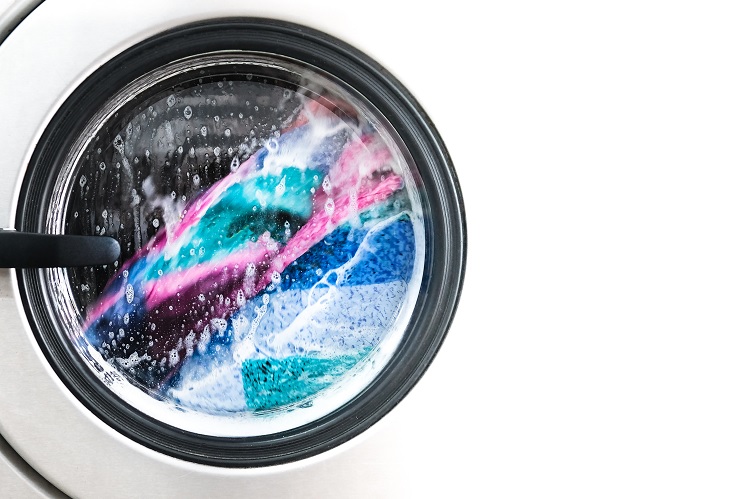Microplastic pollution is a global environmental problem. From the Arctic Ocean to the deepest seafloor sediments, microplastics are found everywhere and their impact on marine life is profound.1

Laboratory research has shown microplastics interrupt the normal feeding and digestion processes of marine organisms when ingested. This is harmful not only to the individual creature but also to the entire marine ecosystem. There is a real threat that this contamination is accumulating as it moves up the food chain.2
The World Wide Fund for Nature (WWF) estimates 90% of seabirds now have plastic in their stomachs.3 A recent study of seafood available at a Californian market found 67% of all species had microplastics in their digestive tracts. The majority of these were identified as fiber fragments released from clothing and textiles during laundering.4
Change is coming
Consumers and governments are aware of the problem and there is a push for change. While there is currently no legislation being enforced concerning the release of fibers from clothing and textiles, this is going to change. The Philippines has a House Bill pending and several bills have been proposed in the US. The state of Connecticut has already passed a bill for the purpose of developing a consumer awareness and education program concerning the presence of synthetic microfibers in clothing. In Europe, the European Union is currently working on a Directive and France has passed a law stating new washing machines must be fitted with a filter to capture fibers by 2025.
Industry is also responding. In September 2021, The Microfiber Consortium (TMC) launched its Microfiber 2030 Commitment and Microfiber Roadmap. These will help manufacturers and brands to meet the TMC vision of zero impact on the environment by 2030.
Terminology
The term microfiber has been in common circulation for several years. It refers to a synthetic fiber with a linear density of less than one denier (1 dtex). While microfibers do constitute a sizable portion of microplastics found in our oceans, the issue of fragment release is not restricted to synthetic fibers. The term microfiber is therefore used only when describing linear density for synthetic fibers.
A better term is fiber fragment. This can be used for the full range of textiles – synthetic, natural and blends. Organizations such as the American Association of Textile Chemists and Colorists (AATCC), Cross Industry Agreement (CIA) and TMC use this term to refer to a textile fiber that is less than 5 mm in length and which has broken away from the main textile body.
Fiber fragmentation
The action of a fiber being released from the textile body is referred to as fiber fragmentation. Minimizing this process during a product’s life cycle is now a major concern for clothing and textile suppliers who are looking to demonstrate sustainability and corporate responsibility.
To achieve the aims of the Microfiber 2030 Commitment, manufacturers must be able to evaluate their clothing and textile products for fiber fragmentation during laundering. This means quantifying fiber fragments in laundry effluent. They also need to be able to assess how different parameters – degree of fiber raising, fabric construction, type of final finishing, etc. – impact fiber fragmentation and compare how different materials will react during laundering. With this information, they will be able to make the right decisions regarding textile choice when developing new products.
Fiberfastness
Consumers and industry want textiles that demonstrate fiberfastness – a textile material/product that resists being broken down during laundering.
Forward thinking manufacturers are actively looking to develop end products that exhibit exceptional fiberfastness performance. A variety of test methods now exist, or are in development, to help them achieve this goal:
- ISO/DIS 4484-1 – drafted by the CIA in collaboration with the European Committee for Standardization (CEN). The results of a round robin trial were released in Sept 20215
- AATCC TM 212 – a small-scale testing method released in August 2021
- TMC test method – released March 2020
Two testing routes exist for manufacturers checking fiberfastness:
- Small-scale – understand fiberfastness during product development by testing textiles under standard conditions to reflect domestic laundering
- Full-scale – part of due diligence, testing on finished garments/textiles using washing machines to simulate real life
Using both small- and full-scale testing regimes, brands and manufacturers can efficiently and cost-effectively develop end products that have good fiberfastness performance. This will enable them to achieve the goals of the Microfiber 2030 Commitment, which will help wildlife and the environment.
SGS Solution
SGS has been involved in fiber fragmentation studies and analysis since 2016.
We released our first full-scale fiber fragmentation testing solution in 2017, and as a research organization helped the CIA develop a small-scale testing methodology. In 2021, we extended our small-scale testing service provision with the addition of AATCC TM 212 and joined the TMC Test Methodology Task team.
With an unrivalled global network of state-of-the-art laboratories, we provide a comprehensive range of small- and full-scale testing services. These solutions can also be used to help manufacturers evaluate efficiency in fiber reducing products, such as filters and washing bags.
Learn more about SGS’s Textile and Clothing Testing Services.
For more information, please contact:
Steve McDonald
Global Technical Manager
Connectivity and Products, SGS
t: +44 (0)7818 514346
References
1 Pervasive distribution of polyester fibres in the Arctic Ocean is driven by Atlantic inputs
2 Single and repetitive microplastics exposures induce immune system modulation and homeostasis alteration in the edible mussel Mytilus galloprovincialis
3 Meet the newly discovered ocean species: plastic
4 Anthropogenic debris in seafood: Plastic debris and fibers from textiles in fish and bivalves sold for human consumption
5 Textile and Apparel Industry Alliance Moves Closer to Release of An International Microfibre Shedding Standard
Related Links
- Product Recalls
Plot # 04, Sector 24,
Korangi Industrial Area, Near Shan Chowrangi, 74900,
Karachi, Pakistan



